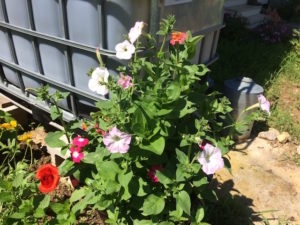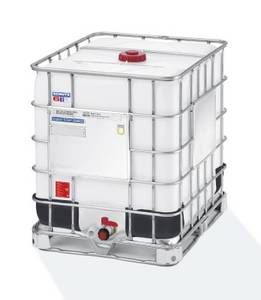Category Archives: Resources
Bee Diagnostics
Our bees are challenging us to learn about queen rearing. After a long period of rain, I checked the bees mid-June and found North Hive had created a new hive under the screened bottom board. S came 6/21 to inspect and help right the situation.
The bees had made ten panels of comb under the hive, several containing eggs and brood. S pushed the foundation out of several empty frames, then cut the comb off the bottom board, one panel at a time. She placed the comb in the empty frames and secured the panels with rubber bands.
Removing the bees from the bottom board was difficult because of all the nooks and crannies. Bees were flying everywhere, and we never saw the queen who had been laying eggs. S hoped we had gotten the queen back in the hive, but we couldn’t be sure.
We made a split, which we subsequently took to her place about 15 miles away. This hive E and I brought back on the 26th and installed in our new bee yard on the west.
I checked North Hive a week later on the 28th and found no new eggs, unsealed queen cups on the comb S had moved, and one hinged queen cell. It looks like we lost the original queen from the underneath colony because the bees made emergency queen cells out of the comb S moved. The hinged queen cell suggests that one of the old cells from inside the upper hive hatched. While she was pupating, the bees made new emergency queen cells.
With no babies to care for, the bees are making honey and filling up the brood cells. I think I need to move things around to provide room for the new queen to lay eggs. I’ll ask S what she thinks.
Based on bee development, I should see mating flights from both the North Hive and new West Hive on about July 1. I should see new eggs about a week later on the 8th. I surely hope all will be well.
Queen Diagnostics: A useful document with numerous scenarios and decision trees for remediation.
Cookeville Beekeepers recommends donating a frame of brood to the queenless hive in order to determine if a queen is present. If not, the workers will create queen cells out of the brood.
Thank you, Linda’s Bees, for the link to Beemaster Forum! Finally, I’ve found the fount of wisdom I need to pull off the extraordinarily interesting and challenging work of beekeeping. Linda also suggests a new frame of brood every week for a queenless hive.
Rain Collection
Spring rain will be coming soon, and we need to collect water or else deal with erosion. Holly Young told me about IBCs (intermediate bulk containers), which she uses on her homestead for collecting water. They’re available through Craigslist for about $75, and they hold five times the water of a 55-gallon drum. Ugly, no doubt, but with enough flowers and tall grasses planted around them, they wouldn’t be so bad. Here’s a plan for putting it all together.
If the committee nixes the IBC, there are other options. Wikihow offers a clear plan which uses 55-gal drums, available in plastic or metal at Rural King for under $20.
Setting Up the Bee Yard
I’ve sited the bee yard, now that we have laid out the orchard. The next step is building a hive stand for the two hives.
This plan for two Langstroth hives looks simple and effective.
We are planning to plant a lime tree, but we need to be careful which one we choose because they can be toxic to bees, and they are susceptible to Japanese beetles, which we have in abundance. Tilia cordata and platyphyllos are both fine for bees. One study finds that June Bride is a good cultivar of tilia cordata. This study suggests tilia platyphyllos ‘Parade’ is a good choice. Sterling and Legend look fine, as well. Where to buy such trees remains a mystery.
Flowers
We ordered wildflower mixes from Peaceful Valley, and now we’re thinking about how to plant them. They’ll be in beds near the bees. I want to entice them to stay home by giving them lots of pollen close to their hives.
Vesey’s offers information on planting a wildflower meadow, which is what we’ll be doing on a small scale.
Planting an Orchard
We’re trying to learn as we go without falling into our perennial problem of all research, no action, but as the Mexican proverb states, “El flojo y el mezquino dos veces andan el mismo camino,” which means the lazy person and the perfectionist both have to do things twice. We don’t want to have to plant our orchard twice.
Permaculturists recommend planting bare root trees with good care but no babying. In other words, don’t give them a wonderfully fertilized little hole that they have to leave as they grow. Good advice for parents, too!
Colorado Master Gardener program gives the most up-to-date science on planting bare root trees. The website includes clear pictures and information.
On the other hand, this info from my mom: “Our county agent and the NMSU orchardist caution that the hole for planting a tree should be straight sided, straight down. For awhile there it was all the rage to dig a bowl-shaped hole. It has been discovered that the roots follow the bowl upward and grow out of the ground rather than outward and downward. Ultimately, death on trees.” Stark recommends a 2′ X 2′ X 2′ hole for bare roots. To keep our warrantee on our trees, we’ll probably have to follow the planting instructions included. Since we ordered from Raintree and Stark, we may get two different sets of instructions.
Phil Williams offers excellent advice, with no compost or fertilizer.
Burlington Permaculture gives information about watering and pruning.
One writer (Walden Effect), quoting The Holistic Orchard, says to remove vegetation for four to six feet in diameter for each tree and mulching with wood chips. This wood keep any remaining grass down and understory plants could be placed in the mulch.
This article offers extensive information about cover crops.
The Philadelphia Orchard Project looks fascinating and has great resources for companion planting.
Deep Green Permaculture gives detailed instructions for pruning fruit trees from bare root onwards.
Local Nurseries and Compost
Working at a library, I have access to all kinds of people, and many of them are avid gardeners. I’ve been collecting the names of nurseries, and here they are.
- Redbud Creek Farm: In Sheridan, this one looks pretty online, and they have natives and perennials.
- Hornbaker Gardens: In Princeton, they’ve got lots and lots of perennials, as well as some trees.
- Danchris Nursery: In Streator (birthplace of Clyde Tombaugh), this nursery also has shade trees. Maybe an American basswood?
- Norway Nursery: Just upriver from us, this nursery specializes in native plants. And, if you buy trees from them, you get unlimited pond water, which is supposedly the best water for newly planted trees.
Compost Supply is just northeast of here, which is lucky for us because compost can be hard to come by. This compost calculator is helpful in determining the number of cubic yards needed.
Wood chips come to us courtesy of Urban Lumberjacks (888-876-0003), who have done lots of tree pruning and cutting for us in the past.
Amazing Resources
If there’s something to know about gardening, my mom has probably at least heard of it. She’s been feeding me resources and books for years, and now I can save them in a better spot–HERE!
Old World Farm: These folks have plans for pergolas and other farm necessities on their Etsy website.
Herbs
We’re planning to have at least two herb spirals, as well as herbs in the landscape and sunroom. Some herbs are not so easy to find, Mexican Oregano (Lippia graveolens), for example. However, I just discovered that Dave’s Garden is not just a great source of information about plants, pollinators, orchards, and the like, but also a plant finder. I’ll be using this resource for finding uncommon varieties.
Comfrey comes recommended highly by permaculture enthusiasts, who list it as a good guild plant for fruit trees. It doesn’t grow well from seed, but may be available from Grower’s Exchange.
Colonial Creek Farm has fascinating, wonderfully aromatic herbs, including patchouli, which can be grown as a houseplant! I would love to visit their greenhouse. This is a great site for birthday shopping (wink, wink). So far, these are the plants on my wishlist:
 |
Patchouli |
 |
Chocolate Mint |
 |
Attar of Rose Scented Geranium |
 |
Lemon Grass (West Indian) |
Mountain Rose Herbs also offers fairly priced herb seeds, many of which are hard to find.
Vegetable Gardening
Mother Earth News list/map of mail order seed suppliers
The Top 15 Vegetable Seed Companies, according to Mother Earth News
- Johnny’s Selected Seeds (Winslow, Maine)
- Seed Savers Exchange (Decorah, Iowa)
- Baker Creek Heirloom Seeds (Mansfield, Mo.)
- Burpee Seeds and Plants (Warminster, Pa.)
- Territorial Seed Company (Cottage Grove, Ore.)
- Seeds of Change (Rancho Dominguez, Calif.)
- Ferry-Morse Seed Company (Fulton, Ky.)
- Southern Exposure Seed Exchange (Mineral, Va.)
- High Mowing Organic Seeds (Wolcott, Vt.)
- Fedco Seeds (Waterville, Maine)
- Nichols Garden Nursery (Albany, Ore.)
- The Cook’s Garden (Warminster, Pa.)
- Botanical Interests (Broomfield, Colo.)
- Renee’s Garden Seeds (Felton, Calif.)
- Peaceful Valley Farm & Garden Supply (Grass Valley, Calif.)


